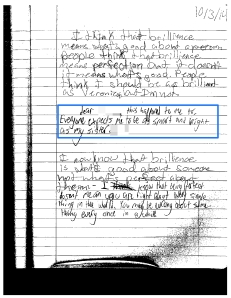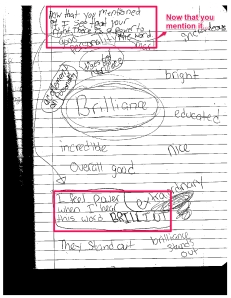We were fortunate to work with author and consultant Ellin Keene last week. We are developing a cohesive approach to vocabulary for our K-8 district, and Ellin facilitated our learning around vocabulary research. As part of her visit, she taught a demonstration lesson to a class of 7th graders.
Ellin used an activity called written conversations as part of her demonstration lesson. For more information on written conversations, Ellin referred us to The Best Kept Teaching Secret by Harvey “Smokey” Daniels and Elaine Daniels. The protocol for written conversations is as follows:
- Students are seated with a partner. The teacher prompts the students with an open-ended question. Examples might be, “What struck you about this text?” or “What are the most important ideas here?” For Ellin’s lesson, the prompt was “Write down everything the word ‘brilliant’ means to you.”
-
Both students in each pair begin writing their thoughts on paper. After 2-3 minutes, the students exchange papers. The students read what their partner wrote and respond in writing. For example, students might agree, disagree, ask a question, affirm their partner’s thinking, or relate a personal anecdote. After another 2-3 minutes, students swap papers again.
-
After 2 or 3 exchanges are complete, students then talk out loud to their partner or participate in a whole-class discussion. Everyone should have fresh ideas about the topic after merging their thinking with a partner.
Here are some examples from our 7th graders’ first attempt at a written conversation. In these examples, their conversation was focused on their own personal understandings of the word ‘brilliant’ after listening to an excerpt from the beautifully written Brown Girl Dreaming by Jacqueline Woodson.
In this first example, you will notice Partner B empathizes with Partner A by writing, “Dear _______, this happened to me too. Everyone expects me to be as smart and bright as my sister _____.”
Sharing and reflecting on a common experience will undoubtedly deepen these students’ understanding of the word.
In this next example, Partner A begins by writing, “I think that brilliance means to be over average of your grade level. You do things that are beyond your level and beyond you.” After Partner B emphasizes (by underlining) that brilliance might mean “an understanding of things and a knowing or perfection of somethings,” Partner A rethinks the definition. Partner A then writes “I know that just because someone is brilliant it doesn’t mean they get everything right. They may be wrong every once in a while.”
It is noticeable here how Partner A’s original thinking shifted slightly after input from Partner B. We wanted students to synthesize their thinking based on another person’s perspective, and we saw a little evidence of that here.
In this final example, Partner A begins with a web of words related to brilliance. She writes “smart, bright, educated, incredible.” Partner B adds “I feel power when I hear this word,” and then Partner A agrees, “Now that you mentioned it I see that you’re right. There is a power to the word.”
Written conversations were the perfect vehicle to help move students from a definitional understanding of a word to a conceptual understanding. I will definitely add written conversations to my writing about reading strategies.





I’m going to try this out this week, for sure! Thank you for sharing! And how LUCKY are you to have Ellin Keene come to your school in the flesh! Wow!
LikeLike
Hi Dana,
My name is Lindsey Donald and I am a student in EDM310 at the University of South Alabama. I love this post! Even in college I still get stumped on different vocabulary words to use. This is a great exercise for students to do to help expand their vocabulary. The examples are great, I will definitely use this method in my classroom.
Thanks,
Lindsey Donald
LikeLike
I like this! I am currently teaching a 7th-8th grade Hymn Study class and we have been looking at the words of the text. This would be a great exercise to do with them. I am always looking for ideas since the majority of the students I work with are PreK-2nd grade!
LikeLike
Fantastic and so timely. I was just thinking about how to enhance the understanding my kids have of the words they have been learning explicitly. This is perfect!
LikeLike
This is wonderful, Dana, and something I want to try out with social studies vocabulary this week. Thanks for sharing the student samples, too – so helpful!
LikeLike